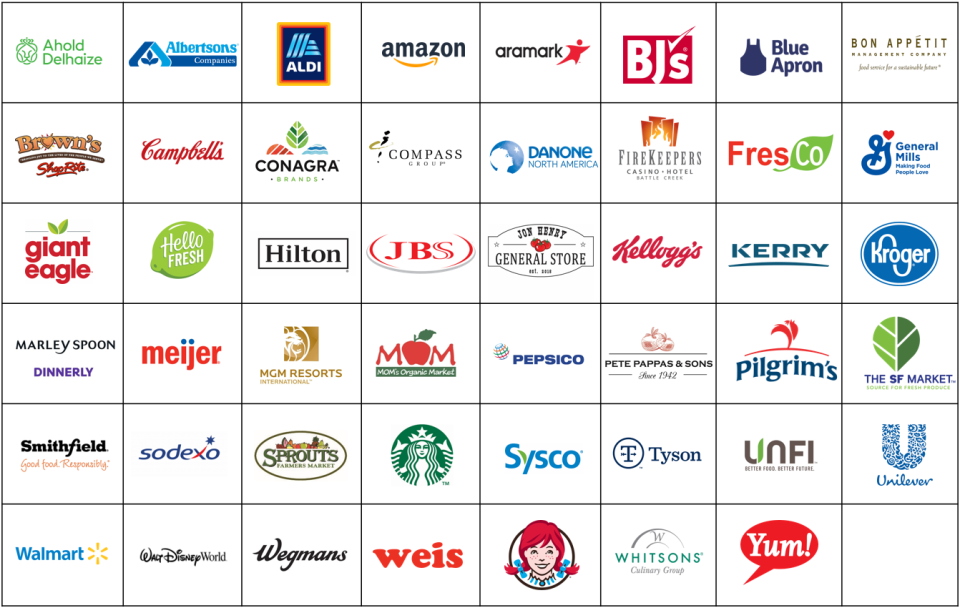United States Food Loss and Waste 2030 Champions
On this page:
- About the U.S. Food Loss and Waste 2030 Champions
- 2030 Champions
- Frequent Questions about the U.S. Food Loss and Waste 2030 Champions
- What is a Food Loss and Waste 2030 Champion?
- How Does a Company Become a 2030 Champion?
- Does USDA or EPA verify the Champions' food loss and waste reduction estimates?
- How is food loss and waste defined and measured?
- Does USDA or EPA provide technical support to measure food loss and waste?
- Why did USDA and EPA establish the U.S. Food Loss and Waste 2030 Champions?
About the U.S. Food Loss and Waste 2030 Champions
In November 2016, the U.S. Department of Agriculture (USDA) and the U.S. Environmental Protection Agency (EPA) announced the formation of the U.S. Food Loss and Waste 2030 Champions group and presented the first set of 2030 Champions.
U.S. Food Loss and Waste 2030 Champions are businesses and organizations that have made a public commitment to reduce food loss and waste in their own operations in the United States by 50 percent by the year 2030.
The staggering amount of wasted food in the United States has far-reaching impacts on resource conservation and food security, while costing businesses and consumers money. To help galvanize national efforts to reduce food loss and waste, USDA and EPA announced the United States’ first-ever food loss and waste reduction goal in September 2015, calling for a 50-percent reduction by 2030. Government alone cannot reach this goal. It will require effort and action from the entire food system. The 2030 Champions have heard the Call to Action and are committed to do their part to help the nation reach this critical goal.

EPA, FDA, and USDA co-hosted a Food Loss and Waste event at USDA’s Whitten Building on October 18th in Washington, DC. The purpose of the event was to celebrate the commitments of the 2030 Champions to reduce food loss and waste in their industrial operations by 2030 and to sponsor a panel to highlight some innovative ways and best practices to educate American consumers on the impacts of food loss and waste, environmentally, socially and economically. The leaders of EPA, USDA, and FDA signed a formal agreement aimed at improving coordination and communication across the federal agencies attempting to better educate Americans on the impacts and importance of reducing food loss and waste.
U.S. Food Loss and Waste 2030 Champions
The following are our current U.S. Food Loss and Waste 2030 Champions who have committed to reduce food loss and waste in their own operations in the United States by 50 percent by the year 2030:

Frequent Questions About the U.S. Food Loss and Waste 2030 Champions
The following are frequent questions about the Food Loss and Waste 2030 Champions.
1. What is a U.S. Food Loss and Waste 2030 Champion?
U.S. Food Loss and Waste 2030 Champions are businesses and organizations that have made a public commitment to reduce food loss and waste in their own operations in the United States by 50 percent by the year 2030.
2. How does a company become a U.S. Food Loss and Waste 2030 Champion?
To join the U.S. Food Loss and Waste 2030 Champions, organizations complete and submit the U.S. Food Loss and Waste 2030 Champions Activity Form (pdf)(202 KB), in which they commit to reduce food loss and waste in their own operations and periodically report their progress on their website.
3. Does USDA or EPA verify the Champions’ food loss and waste reduction estimates?
No, neither USDA nor EPA verify or audit the Champions’ food loss and waste estimates. 2030 Champions are responsible for setting their own baselines and measuring their own food loss and waste reductions. They commit to reporting on their progress on their websites.
4. How is food loss and waste defined and measured?
The exact definition of food loss and waste could vary by country, business and consumer. U.S. Food Loss and Waste 2030 Champions are encouraged to consult the Food Loss and Waste Protocol for information on defining and transparently measuring food loss and waste. It is at the Champion’s discretion whether to calculate the 50% reduction on an absolute or per customer/consumer basis.
5. Does USDA or EPA provide technical support to measure food loss and waste?
In addition to EPA and USDA leads, U.S. Food Loss and Waste 2030 Champions can also contact the Sustainable Management of Food points of contact to access technical assistance for measuring food waste and assessing the positive environmental benefits of waste reduction.
6. Why did USDA and EPA establish the U.S. Food Loss and Waste 2030 Champions?
Reaching the new national goal of cutting food loss and waste in half by 2030, which was announced in 2015, is going to require renewed commitments to aggressively cut food loss and waste. USDA and EPA established the U.S. Food Loss and Waste 2030 Champions initiative as a way of ramping up national efforts to meet this goal. The U.S. Food Loss and Waste 2030 Champions initiative is about recognizing those organizations that have committed to cutting food loss and waste in their own operations in half by 2030 and periodically report on their progress.
